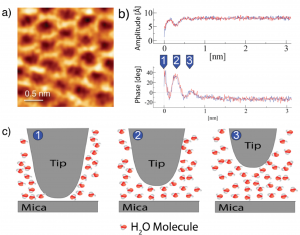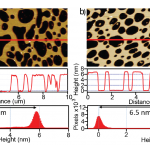Elucidating Water Structure with Ultrasensitive Cantilevers

The local hydration structure at the liquid/solid interface influences the function of adsorbed molecules that can range in complexity from a single ion to complex biomolecules. The low damping, high Q, and low force noise that are characteristic of encased cantilevers enable high resolution imaging combined with ultrasensitive force measurement as demonstrated in the high-resolution image shown in (a) that resolves the muscovite mica atomic lattice. Force measurements on the same surface are shown in (b) and schematically in (c) further illustrate the sensitivity of the encased levers. Three distinct oscillations are observed at the mica surface, representing solvent-molecule layers. To date, three structured water layers have been observed in AFM over assembled biomolecules, but only two water layers have been observed on mica. Moreover, the single force curve measured in (b) was taken in only one second and was not averaged, demonstrating one of the most sensitive AFM measurements of water structure to date. Overall, the increased sensitivity offered by encased cantilevers could push AFM to resolve 2D and 3D hydration layers on surfaces in liquid.
More about this in a presentation.
To learn about additional applications, click here.


